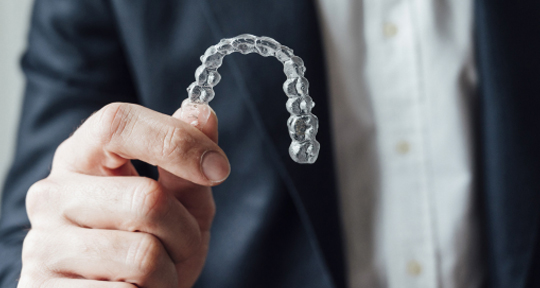Why Some Orthodontists Recommend Braces Over Invisalign
August 6, 2025
DOCTOR PREFERENCE
When it comes to Invisalign versus braces, it’s important to respect a doctor’s preference since most doctors genuinely want the best for their patients. Often, recommendations are based on their experience level and confi dence with various treatment systems. Accordingly, it would probably be unwise to ask a doctor to use a treatment system that is not their preference. However, when a doctor recommends a treatment that is not the patient’s preference, a second opinion may be worthwhile. We often see patients we have diagnosed as routine Invisalign cases, yet previous orthodontic consultations told them they were not candidates for Invisalign.
Here are a few reasons why an orthodontist might not recommend Invisalign:
They have little to no experience or expertise with Invisalign.
They have a high comfort level with braces and don’t want to step out of their zone.
They believe they need to rely on patient compliance.
They can't see how Invisalign could be financially feasible in their practice since the treatment costs the doctor much more than a set of brackets and wires.
There is a learning curve with any new treatment system. If a doctor has a braces system that is working fine, it's understandable why there’s reluctance to implement a new system requiring new workflows, new patient management systems and even new skill sets such as digital capturing of patient data, computer modeling of treatment and more modern methods of managing patient progress. It may take some doctors years to become comfortable enough with these changes to offer Invisalign in their practice.
CUSTOMER DEMAND
Though it’s taken more than 20 years, most orthodontists in metropolitan areas offer Invisalign due to customer demand. These areas generally have more adult patients who demand an alternative to braces versus rural areas, where most patients are children who are still willing to accept braces. Naturally, many doctors are resistant to change, it's human nature. When an orthodontist’s training was with braces and they’ve built systems in their practice to manage that service, they may reluctantly offer advanced products and services such as Invisalign after receiving enough patient requests. This is evidenced by the plethora of television advertisements for prescription drugs, which advertisements are used to get the message out directly to patients who in turn request these therapies from their doctors. You might think that, since you can only obtain these through a licensed physician, it would be more effective to market to the doctors who are the gateway to these products. However, it’s been more effective to get the message out to patients. For example, Invisalign was not getting adequate traction with their doctors until they started advertising directly to their customer audience.
PATIENT COMPLIANCE
Aligners won’t work if patients don’t wear them. By comparison, braces are bonded onto the teeth. So, at first glance, a doctor is giving up a significant level of control choosing aligners over braces. Remarkably, doctors who are experienced in aligner therapy actually say that compliance is less of
an issue with aligners than with braces. Braces require more care in terms of brushing and flossing and avoiding foods and habits that cause them to break loose. Emergency visits for loose brackets and poking wires is rampant with braces. By comparison, there are essentially no emergencies or side effects with aligners. In addition, our special-needs patients do much better with aligners in contrast to braces, especially the kids.
ADVANCEMENTS IN TECHNOLOGY
Fortunately, we now have the technology and skill to analyze and manage patients with a sophisticated mobile app providing us the ability to guide our patients every week. This has become a game changer for Evenly. Remote analysis and management enables us to better guide patients than traditional in-office visits. Our weekly remote office visits better determine when patients are ready to move to their next aligner. The patient no longer needs to guess when they are ready for the next aligner. Typically, with braces or even in office orthodontic aligner treatment, checking every six to ten weeks is often too late. Managing and customizing the time of aligner changes compensates for less than full-time wear and even variable wear, both of which are the norm. By keeping them on track with our Evenly Track™ mobile app, we have minimized patient compliance issues and we can customize a flexible aligner change schedule according to the amount of actual patient wear versus what was originally predicted. Our vibration technology also helps compensate for less than full time wear. Many patients, despite their best intentions, settle into just nighttime wear, which is still workable since our technology and expertise supports this process. The experience of our clinical team combined with our technology makes remote scans as valuable, if not more valuable, than a traditional in-office visit. It takes time to incorporate these technologies in terms of cost and workflow, and it is therefore understandable why some practices are slow to successfully incorporate Invisalign as a new treatment modality.
EXPENSE TO THE DOCTOR
There is also an important financial consideration in using a new system – the
Invisalign system costs the doctor much more than a set of braces. Initially, doctors charged their patients much more for Invisalign than braces, which made the Invisalign option less appealing, especially for children and teens.
Over time, experienced doctors realized that the new technology often pays for itself with shorter treatment times, fewer appointments, no emergency visits and happier patients. The internal marketing benefi t of happy patients, referring friends, family and coworkers, is a huge benefi t to a practice that can help offset the cost of a new treatment system and it takes time for practices to realize these economic benefits.
Furthermore, low-volume doctors pay a higher price for Invisalign, creating an additional barrier to entry and a perverse incentive to use less advanced aligner systems. Using less advanced aligner systems will lead to product dissatisfaction and increasingly push the doctor back to braces. Also, all the advances with Invisalign didn’t happen overnight. More than a billion dollars of product development and the data mining of more than ten million cases have brought product breakthroughs one at a time over the last 20+ years. A doctor who tried the system 10 or 15 years ago and experienced inadequacies, may have erroneously never looked back.
TAKE AWAY
In conclusion, Invisalign in the hands of an experienced practice can now outperform braces for most cases. Computer modeling of treatment means a very direct predetermined treatment course as compared to a series of assessments and readjustments with braces. The aligners are also more comfortable, aesthetically pleasing and more hygienic. Despite this, economic factors, expertise, professional preferences and training make the profession slow to adopt change.

